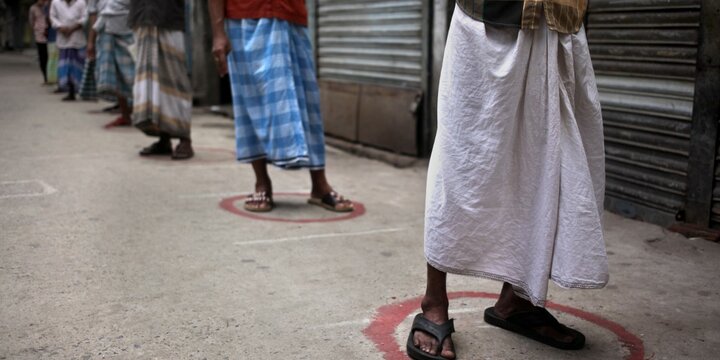The measures taken to cope with the COVID-19 pandemic have resulted in drastic cuts in the labor market. The remittances of migrants to developing economies are also collapsing. As a result, the livelihoods of many families are threatened. In order to respond to the most pressing needs, there is an urgent need for easier and safer access to online transfer services and, above all, a reduction in the costs of money transfers.
For many poor countries, remittances are a mainstay of their economies. According to the World Bank, in 2019 more than 554 billion US dollars flowed into low- and middle-income countries (LMIC). This is comparable to the sum of foreign direct investments in these countries and several times the official development cooperation of the 35 OECD donor countries, which amounted to 153 billion US dollars in 2019.
The importance of remittances for livelihood security and development
More than half of the remittances in 2019 went to South Asia (140 billion USD) and East Asia, including the Pacific (147 billion USD), much less to sub-Saharan Africa (48 billion USD). The dependence of some developing economies on these funds is existential. This is the case of Tonga and Haiti, where remittances account for over 37% of gross domestic product, but also of South Sudan (34%), Kyrgyzstan (29%), Tajikistan (28%) and Nepal (27%). Many poor countries therefore encourage labor migration in order to avoid balance of payments difficulties.
Remittances serve to secure the livelihoods of those left at home and at the same time contribute to growth and development. Households can thus invest in education and small businesses, and women in rural areas can strengthen their independence. However, persistently high remittance costs reduce the amount received. This encourages the use of informal channels, which in turn limits the development of domestic financial markets and their use by private households.
The decline of remittances
The COVID-19 pandemic has changed everything. In the past, remittances were anti-cyclical; in times of crisis and hardship, more money was sent home. This time, however, the pandemic has spread to all countries, creating great uncertainty. The income and employment of migrant workers are under massive pressure and the expectations are that it will continue to decline. Even those who work in developed economies fear for their often-modest income because of the crisis. The situation is exacerbated by the fact that many migrants work in sectors such as construction or hotels and restaurants, which have been severely affected by the crisis. The situation is particularly precarious for those who work in the informal sector in emerging and developing economies.
As a result of the COVID-19 pandemic, remittances to low and middle-income countries are expected to fall by about 20 percent this year to 445 billion dollars. This is 110 billion less than last year. The effects are likely to extend well into 2021. KNOMAD, the Global Knowledge Partnership on Migration and Development, which is also supported by SDC, states in its latest report: “The recovery from the crisis is likely to be prolonged and arduous. Global and regional growth in 2021 is likely to remain subdued. Given these global trends, remittances to LMICs are expected to grow at about 5.6 percent in 2021 to $460 billion”.
Despite declining figures, the importance of remittances as a source of external financing for these countries is expected to increase: The World Bank estimates that foreign direct investment will decline by more than 35 percent – in other words, even more than the remittances. The reasons for this are travel bans, disruptions in international trade and wealth effects due to the falling stock prices of multinational companies. The World Bank estimates that private portfolio flows via stock and bond markets could fall by more than 80 percent.
Expensive and difficult money transfers
The average global cost of international money transfers remains extremely high at 6.8 percent in the first quarter of 2020 and is only slightly lower than in the previous year. Sub-Saharan Africa continues to have the highest average cost at 8.9 percent. In parallel with the decline of the expensive and often difficult transfers, restrictions in international aviation have also stopped informal, personal and money transfers by air freight, creating further problems for families in poor countries. The OECD estimates that the annual sum of these undeclared remittances fluctuates between USD 16 and 35 billion.
Many remittance service providers are restricted due to curfews, shorter opening hours and distance regulations. Around 70 percent of them are experiencing massive business losses. While revenues collapse, operating costs such as wages and rents remain constant. Dilip Ratha, head of KNOMAD, therefore calls for "quick actions that make it easier to send and receive remittances [and thus] can provide much-needed support to the lives of migrants and their families. These include treating remittance services as essential and making them more accessible to migrants”.
Due to these difficulties, the importance of electronic transfers has increased. However, many migrants are still paid in cash. With digital solutions (mobile money), migrant workers could avoid the often-precarious personal transactions, while saving time and money. The transfer of remittances could also be digitalized. However, poor and irregular migrants usually do not have the skills to use digital payment instruments and do not have access to online services. Education and training on the part of authorities and remittance service providers is needed. Due to the COVID-19-related lack of personnel, it has become difficult to carefully check transfers according to international standards in order to prevent fraud and financial crimes such as money laundering. A simplified due diligence check for lower-risk accounts would be a great relief, for example by allowing electronic signatures for low-value transaction accounts or by applying "know your customer" checks such as for SIM card registration to open an account for mobile money. However, this also requires access to appropriate identification documents.
To prevent the decline in remittances from becoming the Achilles' heel of developing economies, Switzerland and the United Kingdom appealed to the international community, on May 22nd, to keep channels for remittances to low-income countries open. The appeal aims to improve access to transfer services by means of additional digital payment options. The appeal, however, ignores the still excessive transfer costs. A reference to the 2030 Agenda goal of drastically reducing these costs "to less than 3 percent and eliminating remittance corridors with costs higher than 5 percent" (SDG 10.c) would have fitted well. Five years after the adoption of the Agenda, nothing has happened yet on this point.









